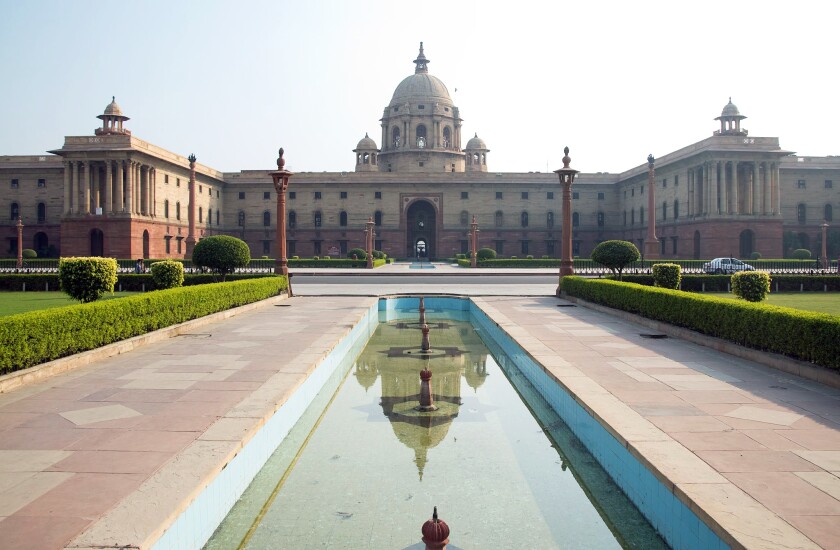SECTION 1: Market overview
1.1 Please provide a brief overview of your jurisdiction's corporate insolvency and restructuring environment and its versatility in cross-border cases. Are there any significant current concerns/debates taking place in the market?
In 2016, India enacted a new law for corporate insolvency and restructuring titled the Insolvency and Bankruptcy Code, 2016 (the Code). The chapters of the Code that deal with corporate insolvency came into effect just over one year ago.
The Code is a radical departure from the law that it replaced, and this radical change has disrupted the way in which creditors deal with bad loans in India. The Code contemplates a time-bound resolution of insolvency, failing which a mandatory liquidation. The Code is new, the precedents are still evolving, and most of the initial cases of corporate insolvency have not yet concluded.
In cross-border cases, a foreign creditor can apply under the Code to initiate insolvency proceedings against an Indian company. However, in order to implement the Code in a foreign jurisdiction (for example, where assets of an Indian company are situated), India needs to enter into a bilateral agreement with the other country. So far, India has not entered into any bilateral agreement with any country.
1.2 What have been the key recent market trends and/or legal developments in the area that practitioners should be aware of?
The Code is new, and some of the key trends and legal developments are:
Banks forced to initiate insolvency proceedings: in June 2017 India's central bank (the Reserve Bank of India or RBI) issued a direction to Indian banks to initiate insolvency proceedings against 12 companies whose collective borrowings was 25% of the gross non-performing assets in the Indian banking system. In February 2018, the RBI issued another notification (number RBI/2017-18/131/DBR.No.BP.BC.101/21.04.048/2017-18) that contains instructions to Indian banks to mandatorily initiate insolvency proceedings if a default in payment continues for a specified time.
Disqualification of controlling shareholders and directors of an insolvency company: on November 23 2017, when Parliament was not in session, the President exercised his constitutional powers to issue an ordinance to amend the Code. The amendments have since been confirmed by Parliament (with some modifications), introduce section 29A in the Code that contains a long list of disqualifications to submit a resolution plan for revival of a debtor.
The disqualifications under section 29A are very wide. In addition to disqualifying the controlling shareholders and management of an insolvent company, section 29A also disqualifies any person (Indian or foreign) who controls or manages a company (in India or outside) that has defaulted on a loan and where the loan has become a non-performing asset for over one year.
Emphasis on selection criteria: when enacted, the Code did not contain any guidance for selection of a resolution plan. Subsequently, section 25(2)(h) of the Code and the regulations were amended to mandatorily require the committee of creditors to specify eligibility criteria for participation in the process and for evaluation of competing offers.
Insolvency Law Committee: the Government had formed a committee to examine issues with the implementation of the Code. The committee has already submitted its report to the Government, and it is expected that Parliament will soon amend the Code to give effect to those recommendations that are accepted.
1.3 Please review any major (recent/current) restructuring cases or initiatives that are influencing activity or court decisions regarding insolvency and/or restructuring cases that have set precedents.
The Code is administered by a special court: the National Company Law Tribunal (NCLT). Appeals from the NCLT go to the National Company Law Appellate Tribunal (NCLAT) and finally to the Supreme Court of India. In the short span of over one year the Supreme Court has considered the following important cases:
Innoventive Industries Ltd v ICICI Bank (Civil Appeal No 8337-8338 of 2017): this was the first major case before the Supreme Court where the scope of the Code and its priority over other laws was in question. The Supreme Court ruled that the Code overrides all other laws even if the Code is inconsistent with those other laws. Innoventive is important not only because it established primacy of the Code, but also because it refers to the objectives of the Code and that is a useful guide for interpretation of the Code.
Macquarie Bank Ltd v Shilpi Cable Technologies Ltd (Civil Appeal No.15135 of 2017): the Supreme Court in Macquarie Bank adopted a liberal interpretation of section 9(2)(c) of the Code and concluded that the requirement to submit a certificate from a financial institution that maintains the account of the operational creditor (to demonstrate that no payment has been made) is not a mandatory requirement. This issue was relevant because the definition of financial institution in the Code refers only to Indian banks and financial institutions. If section 9(2)(c) were to be mandatory, a foreign operational creditor that does not have an account with an (Indian) financial institution, could not have initiated insolvency proceedings against an Indian company.
Jaypee Infratech Ltd v IDBI Bank Ltd: the Supreme Court has exercised its constitutional powers in the insolvency of Jaypee Infratech, a real estate developer that has received advances from a large number of homebuyers and failed to deliver the homes. This case is still ongoing, but the Supreme Court seems keen to exercise its constitutional powers to safeguard the interests of the homebuyers. The outcome of this case may significantly impact the law on insolvency in India, especially where public interest is involved.
SECTION 2: Processes and procedures
2.1 What restructuring and insolvency processes are typically available for financially troubled debtors in your jurisdiction? Do groups of companies receive special treatment?
The following sets-out a brief description of insolvency process in India.
(a) Trigger: default in repayment of INR100,000 (approximately $1,500) – which is due and payable.
(b) Who can apply: a financial creditor (eg a bank) can apply immediately upon default. However, an operational creditor (eg a lessor, or a supplier of goods and services) must first issue a demand notice seeking repayment and can apply only if after expiry of 10 days from receipt of the demand notice: (a) the debt remains unpaid; and (b) the corporate debtor does not bring to the notice of operational creditor, existence of a dispute. A corporate debtor can also apply voluntarily.
(c) Application process: applications are to be filed before the NCLT in the format prescribed in the Insolvency and Bankruptcy (Application to Adjudicating Authority) Rules, 2016.
(d) Admission and moratorium: the date of admission of the application for initiating corporate insolvency resolution process by the NCLT is the insolvency commencement date. A moratorium applies from the insolvency commencement date until completion of the corporate insolvency resolution process. During the moratorium period, the corporate debtor is protected against, amongst others, legal proceedings (including recovery proceedings), and is precluded from alienating its assets or associated legal or beneficial rights.
(e) Interim resolution professional: an interim resolution professional (IRP) is to be appointed within 14 days from the insolvency commencement date. Immediately upon appointment of IRP, the management of affairs of the corporate debtor vests in the IRP, and the board of directors stand suspended. The IRP is required to manage the corporate debtor as a going concern.
(f) Committee of creditors: once the IRP has collated all claims received against the corporate debtor and determined the financial position of the corporate debtor, it is required to constitute a committee of creditors (CoC). With respect to the CoC:
(i) All financial creditors are members of the CoC, except those who are related party to the corporate debtors.
(ii) Decisions at the CoC are taken by vote of not less than 75% of voting share of the financial creditors.
(ii) Each financial creditor is entitled to vote in proportion to the debt owed to such financial creditor.
(iv) Operational creditors (having exposure of more than 10% of outstanding amount) and members of suspended board are entitled to attend meetings of CoC, but are not entitled to vote.
(v) The CoC may elect to continue with the person appointed as IRP or appoint another person. In either case, the person so appointed by the CoC is termed as the resolution professional (RP).
(vi) Approval of the CoC is required for important decisions (listed in section 28 of the Code), which cannot be taken by the RP alone.
(g) Resolution plan: a resolution plan is to be prepared on the basis of an information memorandum prepared by the RP and can be prepared by any resolution applicant (any person can be resolution applicant, except those who are disqualified under section 29A). The RP is required to evaluate all resolution plans and present those resolutions plans, which meet the requirements listed in section 30(2) of the Code to the CoC.
(h) Possible outcomes: if the CoC approves a resolution plan by a vote of not less than 75% of voting share of financial creditors, then it is to be implemented. However, in the following events liquidation process will commence: (i) the CoC rejects all resolution plans; (ii) the NCLT does not receive resolution plan approved by the CoC within the stipulated time; or (iii) the RP intimates the NCLT that the CoC is desirous of liquidating the corporate debtor.
(i) Liquidation: in case of liquidation, the liquidator is required to create a liquidation estate and thereafter distribute the proceeds from the sale of the liquidation assets in accordance with the order of priority specified in section 53 of the Code. Once the assets of the corporate debtor have been completely liquidated, the liquidator may make an application to the NCLT for dissolution of the corporate debtor.
(j) Timelines: the Code prescribes a maximum of 180 days (extendable just once: by up to 90 days, upon application) for completion of corporate insolvency resolution process.
The Code does not contemplate a group insolvency, and if insolvency proceedings are filed against a company, its subsidiaries are not impacted. However, the shares in the subsidiaries that are owned by the insolvency company may be transferred as a part of the restructuring to resolve the insolvency.
2.2 What is the impact on creditors of a formal filing? Are contractual termination rights affected? Are security or individual enforcement actions stayed?
A moratorium applies from the date of admission of the application by the NCLT, and continues until the NCLT passes an order to approve a resolution plan or orders liquidation.
During the moratorium, any suit or proceedings against the debtor cannot be initiated, and the creditors are prohibited from taking any action to foreclose, recover or enforce any of their security.
The moratorium also prohibits the debtor to transfer, encumber, alienate or dispose any of the assets of any legal right or beneficial interest therein. In addition, the recovery of any property by an owner or lessor where such property is occupied by the debtor is also prohibited.
Breach of moratorium is punishable with imprisonment and fine.
2.3 Can a creditor or a class of creditors be crammed-down?
The Code requires that all the decisions of the CoC (comprised of financial creditors) are approved by a 75% voting share (by value of the debt). Accordingly, the financial creditors that constitute the remaining 25% voting share (by value of the debt) can be crammed down.
In addition, the operational creditors are entitled to receive liquidation value, and can be crammed down and receive no payment in addition to the liquidation value.
The liquidation value is the amount that the debtor would have fetched if it was liquidated on the insolvency commencement date and is calculated by valuers appointed for this purpose. Liquidation value is distributed in accordance with an order of priority where secured creditors rank higher than all other creditors (except workmen, whose 24 months dues rank equal to the dues of secured creditors, and the insolvency resolution process cost that ranks higher than secured financial creditors). Most often, the amount of secured debt is higher than the liquidation value, and this results in other creditors not being entitled to receive any payment.
2.4 Is there a process or practice for facilitating the sale of a distressed debtor's assets or business?
Sale of assets or business can be through a resolution plan, and the Code specifies a strict process for submission and approval of a resolution plan. In practice, the process is similar to bidding, where competing resolution plans from potential acquirers are evaluated to select one of them.
2.5 What are the duties of directors of a company in financial difficulty?
The debtor's board of directors is suspended immediately upon admission of the application to trigger insolvency. The powers of the board are exercised by the resolution professional.
2.6 How can any of a debtor's transactions be challenged on insolvency?
If any of the debtor's transactions are found to be preferential, undervalued, defrauding or extortionate, then such transactions can be challenged and reversed by the NCLT.
2.7 What priority claims are there and is protection available for post-petition credit?
Insolvency resolution process cost has the first priority in all distributions, during insolvency or during liquidation. Any post-petition credit, referred to as the interim finance, has superpriority as it is a part of the insolvency resolution process cost.
2.8 Are there any sectors or industries with their own or modified insolvency and restructuring regimes?
The Code does not apply to a financial service provider, defined to mean a bank, insurance companies, underwriters etc. In the insolvency of a financial service provider a separate law is proposed to be enacted.
SECTION 3: Cross-border cases
3.1 Can restructuring or insolvency proceedings be opened in respect of a foreign debtor?
No, foreign debtors are not covered by the Code, and it applies only to companies incorporated in India.
3.2 What recognition and assistance can be given to foreign insolvency or restructuring proceedings?
India needs to enter into bilateral agreements with foreign countries for cross-border insolvencies. As of now, India has not entered into any such agreements.
SECTION 4: Other material considerations
4.1 What other major stakeholders (eg governmental or regulatory institutions) could have a material impact on the outcome of the reorganisation?
A reorganisation may require the approval of India's antitrust regulator – the Competition Commission of India. If such an approval is required, it could have a material impact on the outcome of the reorganisation.
SECTION 5: Outlook 2018
5.1 What are your predictions for the next 12 months in the corporate reorganisation and insolvency space and how do you expect legal practice to respond?
Significant amendments to the Code are expected within the next few months, on the basis of report of the Insolvency Law Committee. In addition, the initial insolvency cases under the Code are also expected to conclude during the next 12 months, setting precedents for future insolvencies. The Code is a new law and is implemented for the first time, and the next 12 months will set the course for law on insolvency in India.
About the author |
||

|
|
Shardul Shroff Executive chairman, Shardul Amarchand Mangaldas & Co New Delhi, India E: shardul.shroff@AMSShardul.com Shardul S Shroff is the firm's executive chairman with over 37 years of extensive experience in corporate advisory, takeovers, M&A, joint-ventures, insolvency & bankruptcy and banking & finance. He is also the national practice head for the insolvency & bankruptcy practice at the firm. Shroff actively contributed in high-powered government appointed committees including the JJ Irani Committee for amending the Companies Act, the Expert Committee on maintenance of Cost Records and Cost Audit and the Eradi Committee for insolvency provisions of the Companies Act, 2013 among others. He has recently been appointed as a member of the Insolvency Law Committee, constituted by the government to review the implementation of the Insolvency and Bankruptcy Code. Shroff is a recipient of the National Law Day Award, 2009, from the President of India and has been consistently rated as a leading lawyer by several international publications. |
About the author |
||

|
|
Ambarish Principal associate, Shardul Amarchand Mangaldas & Co Mumbai, India Ambarish is based in the Mumbai office. His practice focuses on M&A, specifically those involving stressed companies. He has extensive experience advising acquirers in acquisitions of Indian companies through a resolution plan under the Insolvency & Bankruptcy Code 2016. Ambarish has played a leading role in several high profile acquisitions and is presently involved in an over $1 billion acquisition of an Indian company in insolvency by a consortium of Indian and foreign acquirers. He also focuses on Japanese investments in India, and has worked at the legal department of a leading Japanese company in Tokyo, on a secondment. Over the years, Ambarish has extensively advised on matters related to corporate governance, joint-ventures, government policy and drafting of legislations, particularly in the mining sector. He regularly publishes on M&A related matters and also conducts internal training session at the firm on foreign investment laws. |


